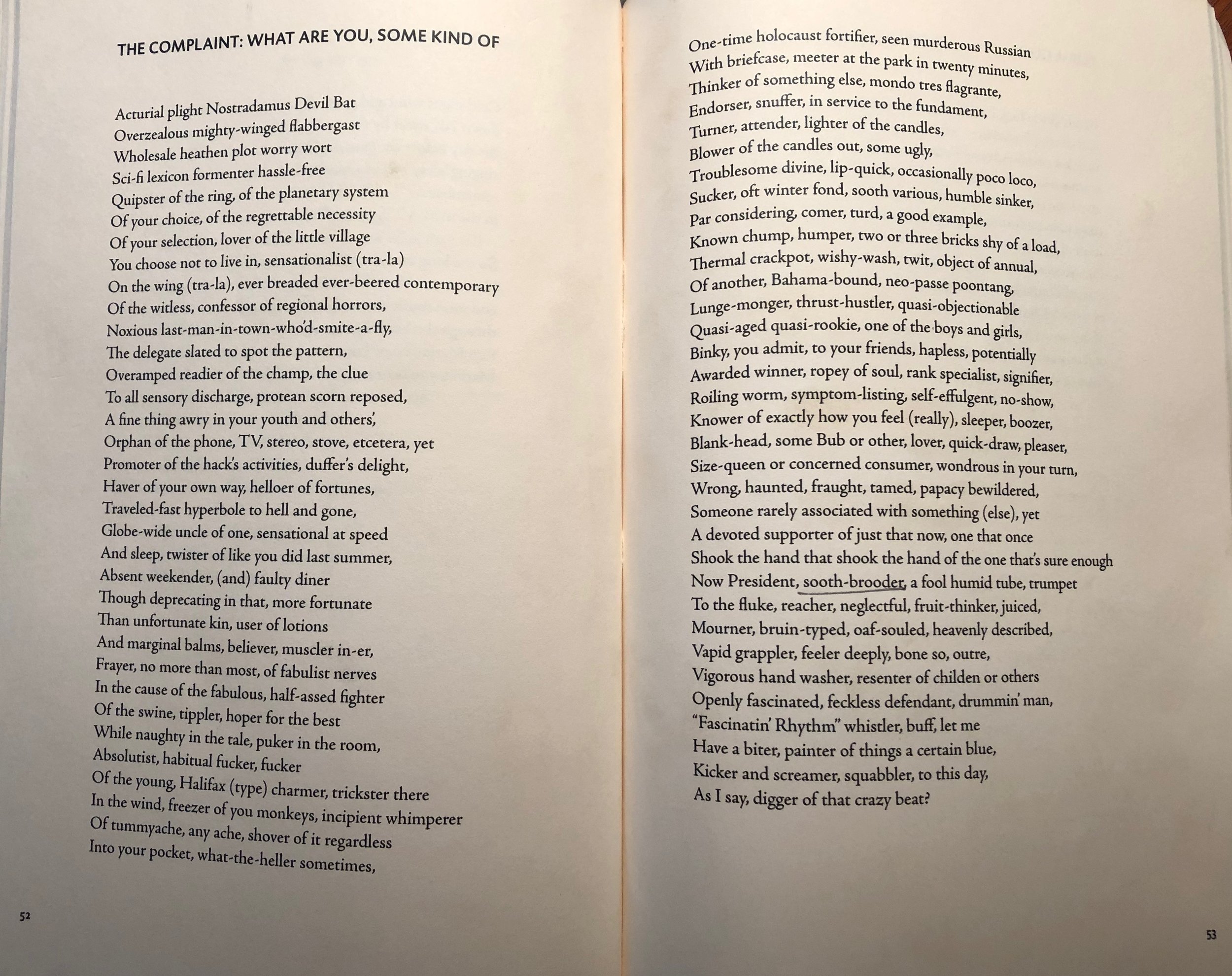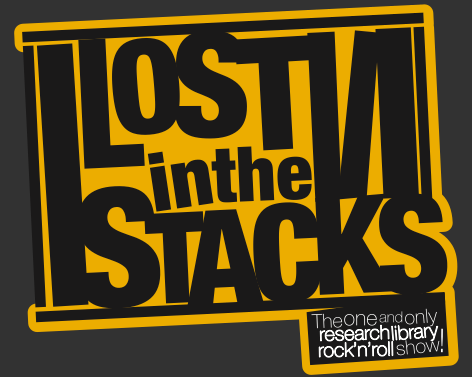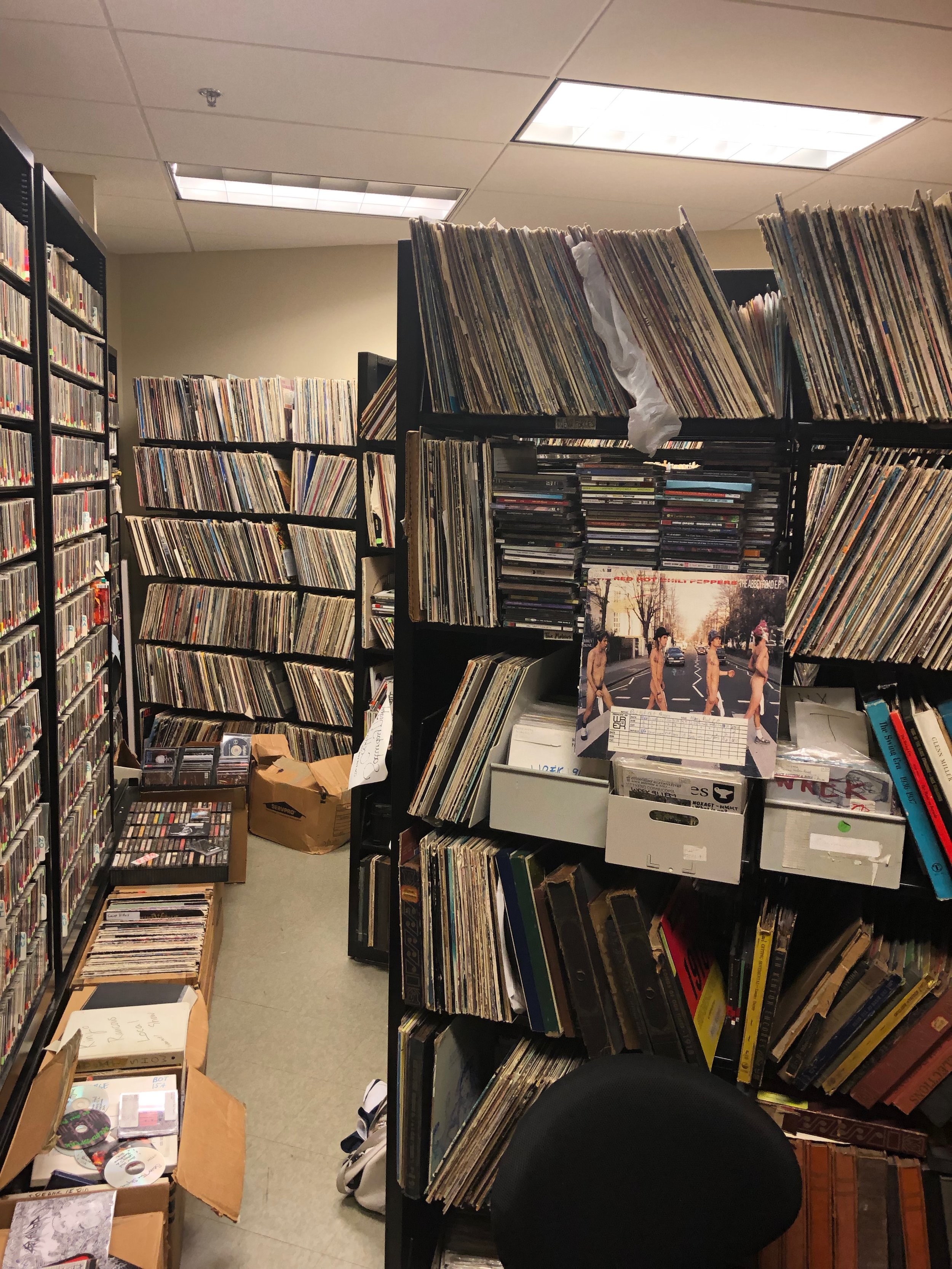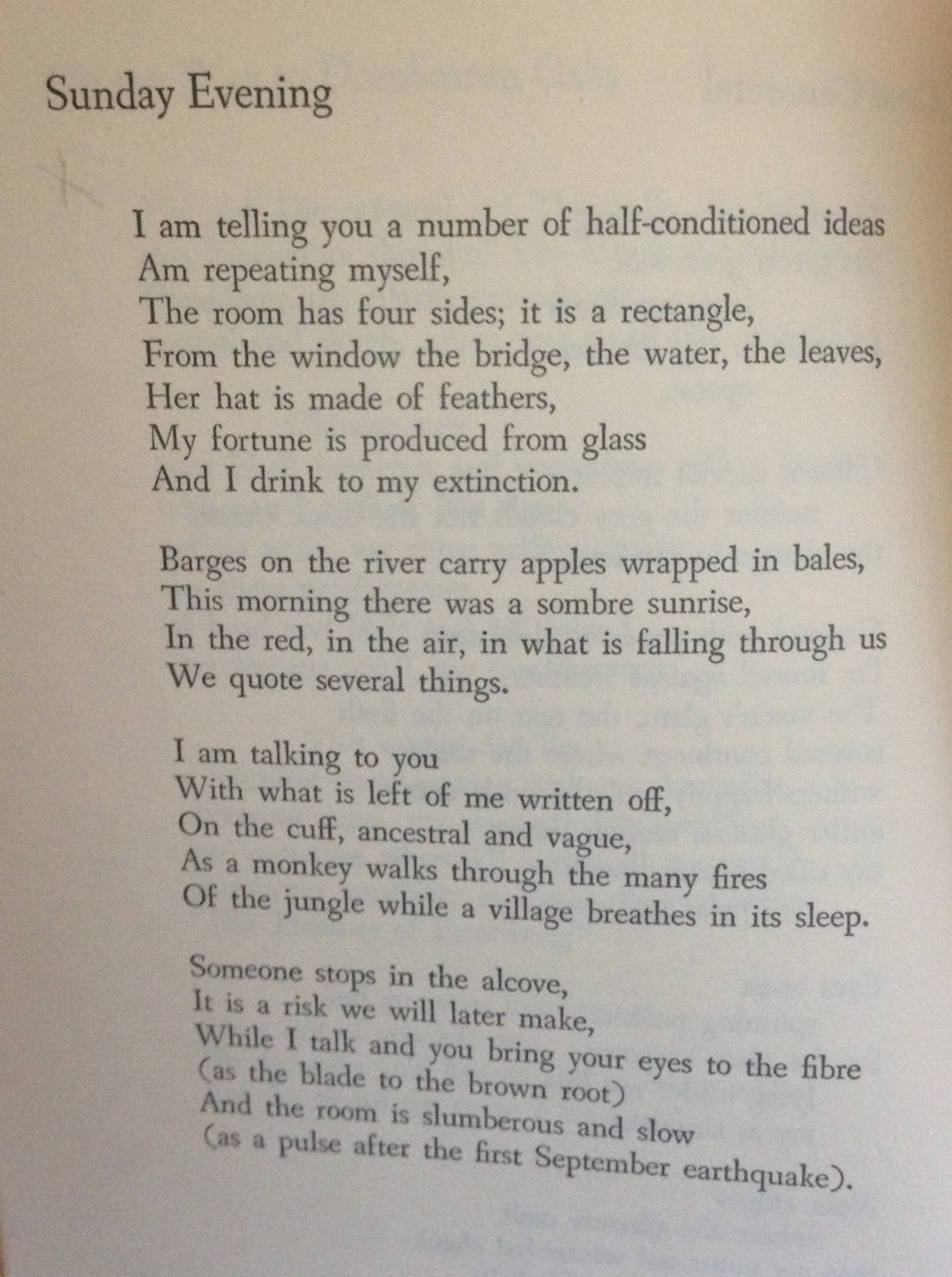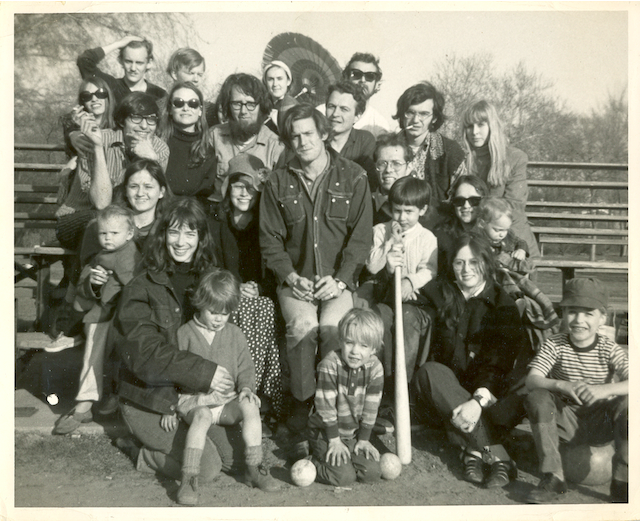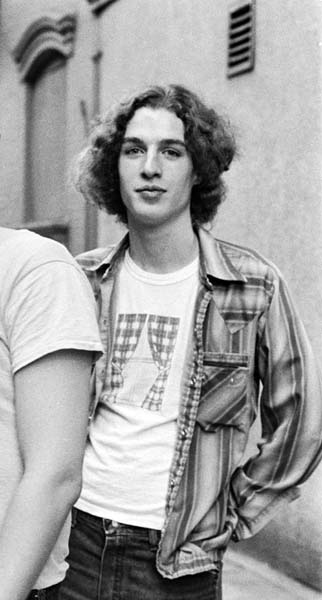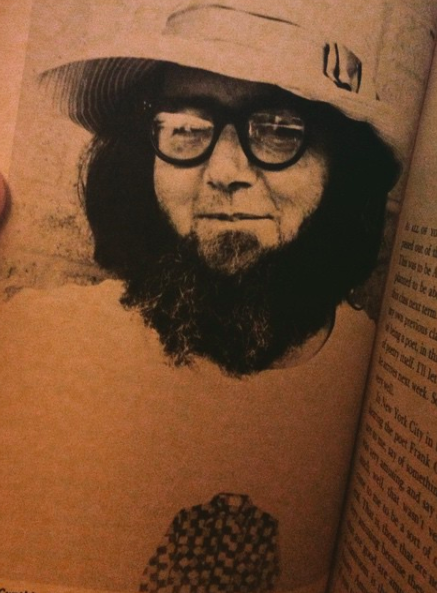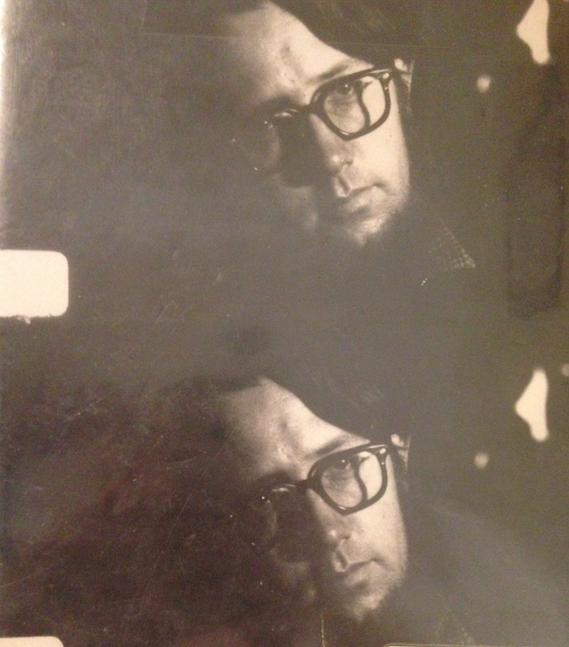Early in the morning on July 24, 1966, around 3am, Frank O’Hara was hit by a dune buggy on the beach at Fire Island. He died in the hospital the next night, July 25, at 8:50pm. J.J. Mitchell’s description of the accident and rush to save O’Hara’s life, including what appeared to be his temporary recovery, is recounted in “The Death of Frank O’Hara,” an elegant, moving piece that appears in Homage to Frank O’Hara, edited by Bill Berkson and Joe LeSueur. Originally published as Big Sky issue 11/12 in 1978, Homage was republished in 1988 by Berkson’s Big Sky books with the support of Kenward Elmslie’s Z Press. It’s a beautiful book full of photographs, elegies, prose narratives, and reproductions of paintings of O’Hara and collaborations with his friends. Copies of the 1988 reprint are still relatively easy to find—there’s a copy for $20 here. I bought my copy for $12 from Open Books in Seattle in 2014. The reproductions of O’Hara’s collaborations with Joe Brainard are really amazing, including one where O’Hara has written in a speech bubble next to a butterfly “I’m not really flying—I’m thinking!”
O’Hara’s funeral was held on Wednesday July 27 at Green River Cemetery in Springs, New York, an occasion memorialized in a handful of the poems, stories, and anecdotes offered by O’Hara’s friends in Homage. As John Button writes, “A center had gone out of our lives.” At his blog, ”Locus Solus,” Andrew Epstein has written about a number of the most prominent elegies, like Allen Ginsberg’s “Midnight City Junk Strains” and, although he did not attend the funeral, James Schuyler’s “Buried At Springs.” Epstein has also written about O’Hara’s obituary and the article about his funeral in The New York Times. Epstein notes that an early edition of the article “200 Pay Tribute to Frank O’Hara” included a dismissive description, later redacted, of the “many bearded, tieless friends of Mr. O’Hara” in attendance at his burial.
Two of those bearded (and perhaps tieless) friends were the poets Ted Berrigan and Jim Brodey. However, among the long list of poets, painters, friends, and family members at O’Hara’s funeral that Brad Gooch mentions in his detailed (and sometimes factually flawed) prologue to the biography City Poet, neither Berrigan nor Brodey are mentioned. Anyone familiar with Berrigan or Brodey’s work know how thoroughly they integrated and reimagined O’Hara’s poetics. Of the two, Berrigan’s associations with O’Hara are generally more well-known, if regularly misrepresented or mythologized. Berrigan had become acquainted with O’Hara in the early 1960s, publishing his poems often in C magazine and socializing with O’Hara at parties and during visits to the Museum of Modern Art. Berrigan and Ron Padgett’s collaborative poem “On Frank O’Hara’s Birthday,” a funny, loving, and performatively imitative spin-off of O’Hara’s style, was published in the Summer 1965 issue of C. Berrigan studied O’Hara’s work closely, inheriting and remaking O’Hara’s complex music, wit, and attention. O’Hara’s influence on Berrigan is obvious but not as obvious as some critics, like Marjorie Perloff and David Lehman, might want you to believe. There’s a lot more to be said about this. Nevertheless, that such a conversation exists at all is evidence of the many claims made about the connections between O’Hara and Berrigan.
Cover of the Jim Brodey issue of 432 Review (Issue #3, 1976). Design by Rochelle Kraut.
On the other hand, Jim Brodey remains sidelined in scholarship on the New York School. His books are out of print and hard to find, although among the poets who knew him his work is tremendously important. Brodey met O’Hara in his poetry course at the New School—he was also taking classes with Kenneth Koch, LeRoi Jones, and John Cage—and soon entered O’Hara’s social and personal life. “Frank took me to the opera and the ballet,” Brodey writes, “[H]e took a personal interest in my poetics, as well as my life.” He and O’Hara had a sexual relationship and in 1965, in O’Hara’s 791 Broadway loft, they collaborated on a long poem, “Acid Rock,” which remains uncollected. Brodey also turned O’Hara on to Bob Dylan. In a review of Dylan’s Blonde on Blonde for the underground newspaper The East Village Other, published a little over a month after O’Hara died, Brodey writes that “When I played ‘Sad Eyed Lady of the Lowlands’ for the late poet, Frank O’Hara, he said that it had such ‘sweet Rimbaud lyricism.’” O’Hara told him “that Dylan really reminds me of Auden, when he was younger. In the sense of being a ‘public poet.’” “O’Hara also said that he was surprised at how much he liked Dylan’s songs,” Brodey writes. Amazing.
Berrigan and Brodey contributed to Homage—Berrigan’s “Frank O’Hara” is included, as is Brodey’s poem “2-Egg Cake,” which opens with the line “O’Hara’s language shining straight through to Flagstaff”—but both poets wrote important accounts of O’Hara’s death and funeral that are not included in Homage. Berrigan’s obituary for O’Hara, “Frank O’Hara Dead at 40,” was published in the underground newspaper The East Village Other on August 1 and has not been republished. (I first learned about it from a footnote in Perloff’s Frank O’Hara: Poet Among Painters.) Dated July 27, it was written on the day of O’Hara’s funeral. Peter Schjeldahl actually refers to Berrigan’s obituary in his own marvelous obituary-essay on O’Hara, published in The Village Voice on August 11 (now available here) and included in Homage. Likewise, Brodey wrote an extended, moving account of O’Hara’s funeral in an 18-page prose memoir “Cotton-Mouth Whirlpool” published in the Jim Brodey issue of 432 Review, a legal-size mimeo poetry magazine edited by Simon Schuchat, in 1976. There’s a lot of incredible moments in Brodey’s memoir, including Marianne Moore giving a young Brodey her copy of Ashbery’s Some Trees at her birthday party, but his narrative of O’Hara’s funeral is particularly affecting. His descriptions of finding out the news from Berrigan, of everyone’s various grief at the funeral, and the mysterious, other-worldly conclusion where Brodey returns to the cemetery are all incredible. Brodey’s account is also notable for offering a different perspective on what Gooch describes as Larry Rivers’s “violent eulogy,” which supposedly made many people uncomfortable with its vivid descriptions of the injuries to O’Hara’s body, calling it instead “the most incredible speech I ever heard,” a showing of “all that strength I’d always admired” in Rivers. “I was just holding on for dear life,” Brodey writes.
So today, 54 years after O’Hara’s death, I’m posting these two pieces by Berrigan and Brodey, both of which should be accounted for in any future work on the younger New York School poets’ relationship to O’Hara. I’ve retyped both pieces in full (retaining unique punctuation) and included an image of Berrigan’s article as it appeared in The East Village Other. It’s worth noting the announcement for upcoming events at St. Mark’s Church in the lower left corner, including “Jazz in the Courtyard” concerts and a poetry reading featuring Berrigan, Peter Orlovsky, and Ed Sanders. These were some of the final events at St. Mark’s Church—where the readings previously held at Le Metro cafe had moved to—before the official beginning of The Poetry Project in September 1966, a reminder that O’Hara’s death and the shifts in the New York aesthetic landscape generated by the Project were nearly simultaneous. At the end of this post I’ve included the two photographs of O’Hara’s funeral service in Homage taken by Camilla McGrath. Paired with Brodey’s account, one is brought more fully into the scene than any other narrative of that day I’ve read before.
Frank O’Hara Dead at 40
from The East Village Other, Volume 1, Issue 17, August 1-15, 1966
Frank O’Hara is dead. He died Monday night, July 25th, at Bayview Hospital, Mastic Beach, L.I., after having been struck by a taxicab on Fire Island early Sunday morning. He was 40 years old, and lived at 791 Broadway.
The loss is incalculable and all but unspeakable. The loss of the man makes the air more difficult to breathe in. The loss of the poet can be compared only to the equally tragic early deaths of Guillaume Apollinaire and Vladimir Mayakovsky, the two poets in this century perhaps closest to Frank O’Hara in style, spirit and stature.
He had five books of poetry published: “A City Winter and Other Poems” (Tibor de Nagy, 1953), “Meditations in An Emergency” (Grove, 1956), “Second Avenue” (Totem, 1958), “Odes” (Tiber Press, 1960) and “Lunch Poems” (City Lights, 1965). In addition, the entire issue of “Audit” Magazine, Vol I, No. 4, (1964) was made up of his poems and his essay “Personism: A Manifesto”, and two essays on his work. These books, plus the many poems in such magazines as “Evergreen Review,” “Locus Solus,” “Yugen,” “C” Magazine, “Folder,” “The Floating Bear” and many others, and the poems in Don Allen’s Grove Press Anthology, “New American Poetry 1945-60”, have been as much responsible for changing the face and figuring of poetry in our time as have the writings of any other poet writing today. The existence in our universe of such poems as “In memory of my Feelings”, “Hatred”, “Poems For the Chinese New Year & For Bill Berkson”, and “Rhapsody”, to name but a few, has electrified and purified our air, and no poet has escaped the charge Frank O’Hara’s poems has generated. In one brief poem, “The Day Lady Died,” he seemed to create a whole new kind of awareness of feeling, and by this a whole new kind of poetry, in which everything could be itself and still be poetry. Simply for this we loved him before we even met him.
His essay, “About Zhivago and his Poems”, Evergreen Review No. 7, is a brilliant and moving personal statement of artistic principle. In it, speaking about Pasternak, Frank O’Hara wrote: “[his] epic is not the glorification of the plight of the individual, but of the accomplishment of the individual in the face of almost insuperable sufferings which are personal and emotionally real, never melodramatic and official.” And later on, “As he scribbled his odds and ends, he made a note reaffirming his belief that art always serves beauty, and beauty is a delight in form, and form is the key to organic life, since no living thing can exist without it, so that every work of art, including tragedy, expresses the joy of existence. And his own ideas and notes also brought him joy, a tragic joy, a joy full of tears that exhausted him, and made his head ache.”
And in closing his Zhivago essay Frank O’Hara told us much about himself. He finished by saying: “And if love lives at all in the cheap tempestuousness of our time, I think it can only be in the unrelenting honesty with which we face animate nature and inanimate things and the cruelty of our kind, and perceive and articulate and, like Zhivago, chose love above all else.”
Kenneth Koch has written somewhere that “Frank’s presence and his poetry made things go on around him which could not have happened in the same way if he hadn’t been there.” This is the essence of the loss, and nearly says it all. The happy saving exception to such a finality is this: that in the six years and more since the Grove Press Anthology was published, and with the increasing availability of Frank O’Hara’s work in many more areas than simply poetry, the man’s remarkable presence in his poetry has been and continues to make living be happening in ways which would not be the same without him.
Ted Berrigan / July 27th
*****
The following is an excerpt from “Cotton-Mouth Whirlpool (episodes from a life),” an 18-page prose memoir by Jim Brodey published in the Brodey issue of 432 Review, the legal-size mimeo magazine edited by Simon Schuchat, in 1976. The Brodey-O’Hara collaboration “Acid Rock” also appears in this issue. (Note [added 8/2/20]: It’s likely that Brodey’s account isn’t quite truthful, but rather is a mixture of truths and half-truths, collages of others’ memories, and some completely fabricated details.)
“Frank O’Hara’s Funeral” from Cotton-Mouth Whirlpool (episodes from a life)
I was just recently back from California. I’d gone out there to be at the first Berkeley Poetry Festival. Ted Berrigan, and Ed Sanders, and I were the “New York Contingent.” Anne Waldman and Lewis Warsh were there, but they hadn’t yet made it to New York City to loom large on the scene there, as yet. John Sinclair, whose various small underground newspapers had carried alot of my EVO-era writing, and I spent most of our time together. We smoked joints with John Weiners, were introduced to Neal Cassady, and spent some time in the San Francisco hills with Allen Ginsberg and a huge throng of hairy people “discussing eternity.”
I was back to New York City, it was an unusually hot summer, and I bumped into Ted Berrigan in the old East Side Bookstore, and he told me that O’Hara was in the hospital. I thought he meant that Frank was just in for a check-up, he’d had some trouble with his back or knee just before I’d left for SF.
Ted said he’d keep me informed as to what he heard about Frank. Later that same night, Ted phoned me and asked if he might come over. He did, and we sat in my little apartment, the floor completely covered by manuscripts and record albums and Siamese cats. Berrigan, the brilliant soul, looked very tired, red-eyed, and really down. He said that Frank had died in the early hours of that day. It took me several minutes to focus on what he was saying. I went into a deep shock scene immediately. And everything that happened right after that, the funeral, the weeks thereafter, was done and seen and lived under a heavy wet blanket of numb shock.
It took me a long time to recover, if one ever does, from the initial few minutes of total realization. Recently, Berrigan and I talked quietly in his St. Mark’s rooms, about that day, the funeral, and about Frank. Luckily Ted began crying, and I just couldn’t hold back either. It is always like it happened just yesterday. It’s very difficult for me to articulate all this here and now. I have to stop and just let me all out again.
Frank had so many close friends, but you know, he had a way of making each and every one of them feel as if they were individually the one and only friend he had in the whole cosmos. He had this thing about contact with you, it was uncanny. And it was really real. Grief is such a personal thing. I never burden anyone with the really deep well of feeling I will have until my own death, for O’Hara. I loved the guy. It’s that simple. There are just certain people in everyone’s life that you wind up owing a debt that you could never repay. And Frank was someone like that. And when you get as close to someone as I was with Frank, well, again it’s so fucking hard to spill your guys out, and be cleansed of it. I don’t ever want to feel like we’re not still in contact. Oh yeah, shit, he’s still around. I get that old feeling of his immense presence from time to time. Once in California, I locked myself in a bathroom in a house I was living in at the time (circa 1968) and wept for two days! And I hear everyone he knew sees him too, not just feels him stirring around inside themselves. It would take 200 pages to tell you all the things he taught me, said to me, and left me with. The only thing I deplore about this whole scene, younger people especially, but a few older ones as well, are those people who didn’t like him when he was alive or are climbing on the band wagon now that he is really super-famous. The ones who never knew him at all, really piss me off. It’s all getting too creepy.
He was the true leader of us all, but he would’ve just said, in that beautifully faggy voice of his, “Oh stop it, you big shit.”
The actual funeral scene. Berrigan and his first wife, Sandy, Mike Goldberg, and Karen Edwards, and me rode out to the cemetery at Springs, on Long Island, together in artist Bob Cato’s huge car.
I remember kneeling over the grave, in a suit, feeling sort-of sick-to-my-stomach. There was a little crowd of friends. The Museum of Modern Art had chartered a small school bus to bring his fellow employees out. Over a little hill at the other end of the cemetery came Larry Rivers and Allen Ginsberg looking very tired and really strange. Edwin Denby was wearing his heart on his face. John Ashbery was constantly in tears, great gushes flowing down his face onto his dark suit. I remember planting my feet firmly in one spot and alternately watching Mike Goldberg, whose eyes were real glassy, and whose body was some great source of strength for me in those moments. He was rock-steady, and I stood next to him, trying to get myself to stay standing. There were little patches of people here-and-there around the grave. Peter Schjeldahl and his first wife, Linda. Tony Towle’s face was just flushed with pain, I couldn’t look directly at him, or I would’ve cracked up as well. I was just holding on for dear life. I remember it like it was just a few minutes ago.
Kenneth Koch and his wife, Janice, were there too. Ken looked really drawn-in tight. I’d never seen him look so distraught. Mostly I watched the grave itself, keeping my face downward, and my eyes glued to the marker. The eulogies began. Bill Berkson, John Ashbery (who had to stop and be led away for a few minutes, he was crying so much!). It was during Ashbery’s speech that I began to swoon and would’ve collapsed, except that Allen Ginsberg (and old hand at these affairs) was right behind me holding me up with supportive hands on my lower spine and back. If he hadn’t gently supported me then, I would’ve hit the ground, for sure!
Edwin Denby was likewise overcome and didn’t speak too much. But Larry Rivers, immediately showing all the strength I’d always admired in him, gave an incredible of-the-cuff summary of just exactly how each and every one of us there felt. His was the most incredible speech I have ever heard. He described how Frank looked at the hospital, his beautifully noble broken Romanesque nose and face was distorted with tubes running into nose and mouth. His head was blue with broken veins. The powerful speech made alot of the people there swoon, loudly sobbing, and swaying with chills. I stepped backwards and just had to walk away slowly, up the little hill there, and sit, leaning against the great stone that marked Jackson Pollock’s grave.
After the ceremony, we all filed past Frank’s grave, nobody talking.
People were still arriving. Alfred Leslie, the painter and film-maker, who Frank had collaborated with on a film, THE LAST CLEAN SHIRT, arrived in his beach garb. He’d just heard about it all out on the beach, and come real quick to see if it was true.
I remember Goldberg put his arm over my shoulder, and I began to cry, finally getting it out of me, walking towards the graveyard entrance, hand-in-hand with Karen Edwards, while Mike walked comforting his ex-wife Patsy Southgate, some few feet behind us.
We went over to Norman Bluhm’s house for coffee, Ted, Sandy, Mike, Karen, Bob Cato, and me. I went for a short walk in the woods, sobbing. Then I heard the most curious sounds. I broke through some underbrush, and was mysteriously back at the cemetery grounds. There on his knees, on top of the grave, was Ginsberg! Tinkling his finger cymbals together in unison, and chanting a mantra for Frank’s spirit’s ears alone. I laid in the soft grass at the lip of the graveyard’s clearing, crying in a slow wind, laying there half-hearing Allen’s incantations, and half-seeing Frank’s immortal red-rimmed eyes watching it all, taking it all in. He’s still watching and we all know it!
*****
Below: Two photographs of O’Hara’s funeral service at Green River Cemetery on page 137 in Homage to Frank O’Hara. In the bottom image, one can identify—from left to right—Bill Berkson (in a suit, arms crossed, looking down), Edwin Denby, Larry Rivers reading his famous eulogy described above by Brodey, and John Ashbery in sunglasses with his hands folded in front of him.








